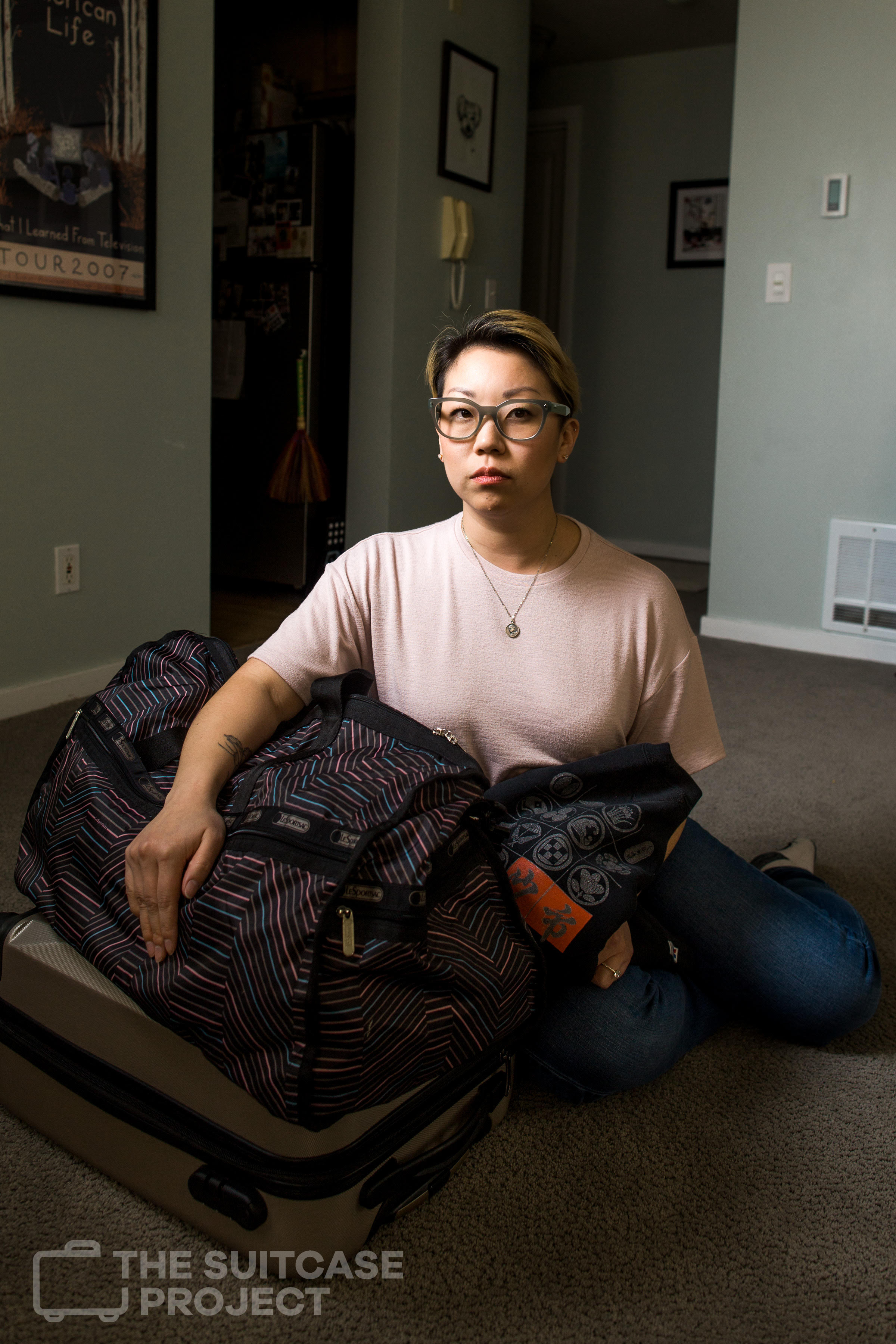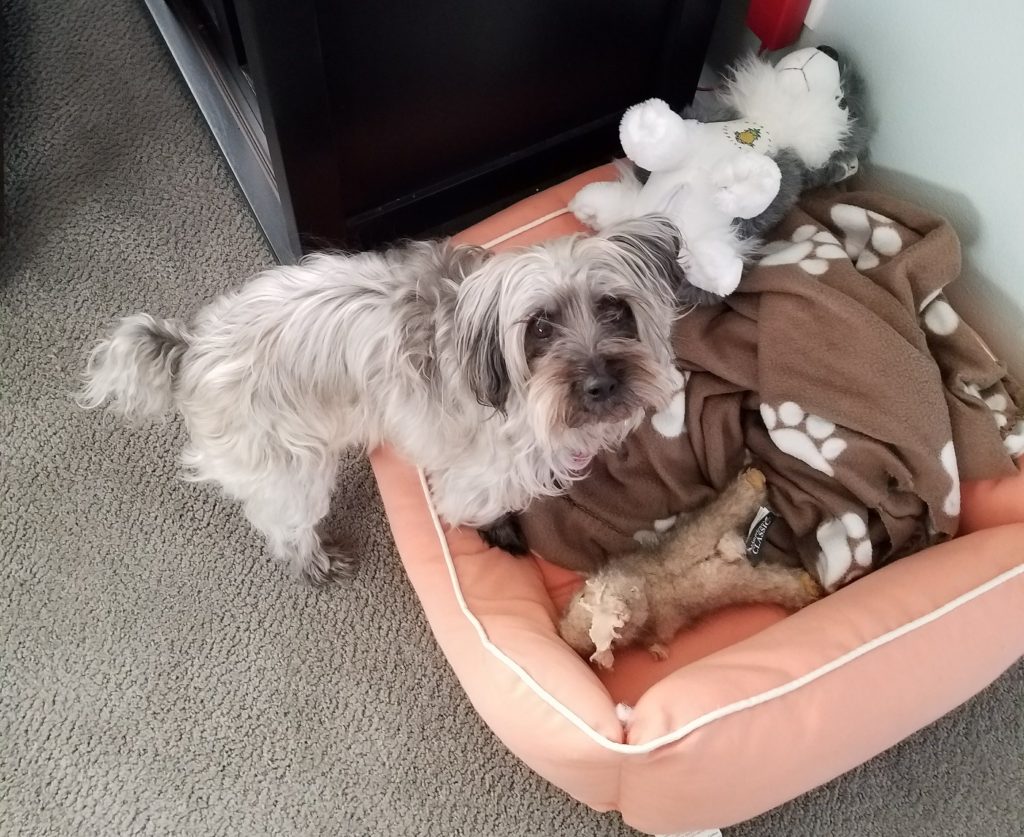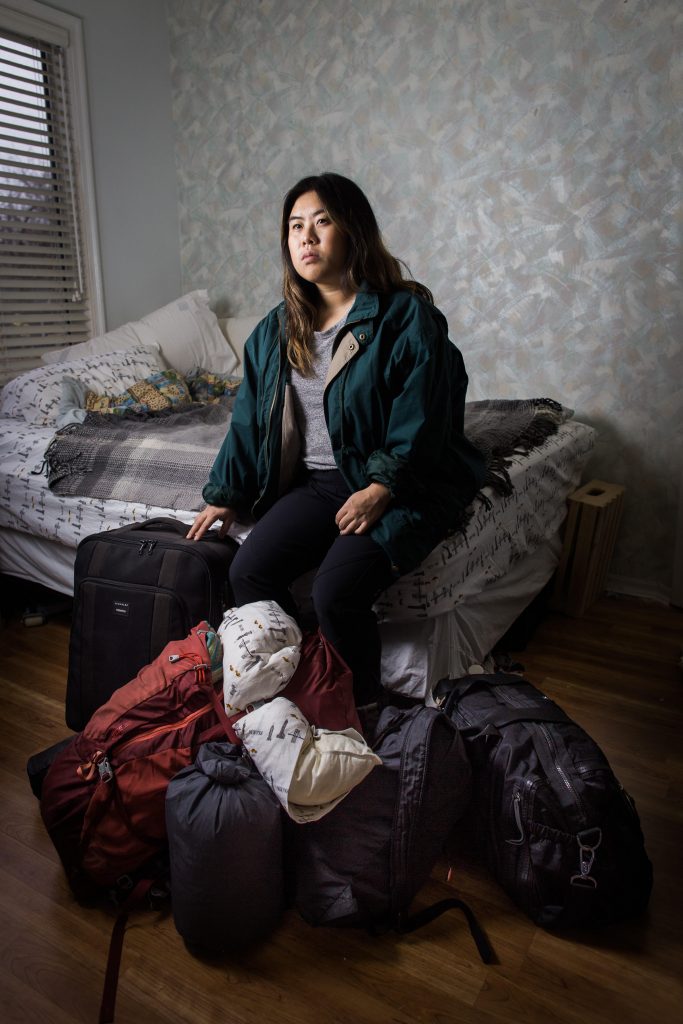May 16, 2018
Danielle Higa, Densho Fund Development Manager and Suitcase Project participant, on what she would pack if she were forced into incarceration and what came up for her during the course of the project:
“To be completely honest, I was not sure about what to pack. I felt unprepared and a little overwhelmed but it was a great experience with Kayla Isomura and Mark Yuen, the videographer. My grandmother, Hatsumi “Hats” Higa (nee Kosai), and her family had no idea where they were going after the FBI arrested my great-grandfather. She and her family were eventually sent to Pinedale detention facility, then Tule Lake, and Minidoka concentration camps.

“I first thought about the items that meant the most to me, that were easy to pack and things I cannot replace. I have a black sweatshirt given to me by my Grandma Higa that I wear often — I immediately put that on my priority list. The sweatshirt design is filled with Japanese mon or emblems that are used to identify families (family crests) and a Daruma, a symbol of good luck and encouragement. I remember my Grandma wearing this sweatshirt a lot and she gave it to me to wear a couple years before she passed. I’ve worn it in Japan, on the East Coast and people always ask where I got it. (Fun Fact: The sweatshirt was designed by Frank Fujii, a local Seattle artist and former teacher who passed away in 2016.)
“Another item I could not leave behind is a corsage Grandma Higa made in camp. I think my grandmother made it while at Tule Lake. It has faux flowers with an off-white ribbon tied into a nice bow and small white seashells. She said they kept busy with crafts, activities, and clubs. She gave this to me when I asked if I could interview her for an Asian American Studies 101 paper about World War II. To hear about this traumatic experience from my own Grandma was deeply emotional. I had all the feels during this photo session with Kayla because it stirred up memories of my grandma. Like her, so many other Nisei have passed away and this project is a reminder that this could happen again in our country so we need to be the allies our community did not have back then.
“The first item I grabbed out of my closet was the happi coat that my grandmother also gave me. She used to bring it from her house so I could wear it during Bon Odori every summer, and since I loved going out into the street to participate in the dances, she said I had to put it on because it says “Shiga Song” on the trim. Shiga is where her side of the family comes from. She always volunteered in the nikudon (beef over rice) booth and every time she’d spot me in the crowd, she would buy me a bowl of nikudon and then hand me the happi coat. If you knew her, you’d laugh because she had a way of telling us what to do with humor and sass. When I was finishing college, she said I could keep the coat but I had to remember to bring it to Obon every year (I guess at the age of 21, she finally trusted me with this happi coat haha).
“I also packed my University of Washington bucket hat as a reminder that I was a Seattleite and a Husky. Knowing that we would go to a desolate area with extreme weather, this hat could come in handy. If I was to be incarcerated because of my ancestry, I want to show that taking away our rights as citizens wouldn’t make me forget that I have a loving family, an awesome career, a quality education, and strong dedication to my community as a Yonsei. I would remain loud and proud about being Japanese American, even if the government saw our community as a threat to national security.
“Among the bed sheets, linens, and other typical items you take when you move, I had some photographs of my family members and my fiancé, Francis. My siblings and I are close; two out of the three of us are in Seattle. My brother is in New York, so if West Coast Japanese Americans were incarcerated in 2018, we would not be together. I packed a photo of my fiancé Francis and me. He is Filipino American (via Canada) and we would be separated if Japanese Americans were incarcerated again.
“There are many sad stories of families parting ways with their beloved pets as pets were not allowed in camp. I cannot imagine needing to leave my dog behind. Her name is Zodi and she is the one thing I wish I could bring with me, no question.

“This activity gave me a new understanding about what my grandmother and her family went through. It made me aware that even as a Yonsei, this experience still affects my generation. I am so thankful to have a great number of resources to guide us to learn more, particularly the Densho website and projects like this that enable us to learn history through art and other mediums. After the photo session, I realize there are still unresolved feelings and intergenerational trauma that need to be explored. My grandparents all have unique experiences during WWII (one grew up in Hawaii, another was in a private Catholic prep school in Spokane, a Kibei Grandma in Japan for high school, then this project centers on the one in camp) and I still wish I could understand each of their experiences better.”
Photographer Kayla Isomura on what compelled her to initiate this project and some things she’s learned in the process:
“Growing up in Vancouver, British Columbia, I didn’t know much about the Japanese side of my family. It was only a few years ago that I learned of their internment* and how that led to their eventual settling down in eastern Canada after WWII. My grandparents and great grandparents on the Japanese Canadian side of my family passed away before I could ever meet them, yet about a year ago I found myself wondering what they would’ve taken with them in 1942.
“In Canada, more than 22,000 Japanese Canadians living on the West Coast were interned during the war. Shortly afterward, the British Columbia government sold all possessions and property belonging to them, and eventually they were told they weren’t allowed to return to the coast, forcing them east of the Rocky Mountains or exiled to Japan. My grandmother’s family would’ve traveled from Prince Rupert, a port city on British Columbia’s north coast, to Vancouver; an 18-hour drive today. Her family was detained in Hastings Park before being relocated to Tashme, one of eight internment camps** in British Columbia. My grandfather’s family was living in Vancouver at the time and was directed to Greenwood, about five and a half hours east of Vancouver.
“Today, our community is dispersed across the country, a legacy that has altered how we associate and connect with each other. Sadly, the assimilation of Japanese Canadians into white Canada worked in a lot of ways. Of the fourth generation Japanese Canadians I know, growing up disconnected from any kind of Japanese Canadian community or from other Japanese Canadians is a common thread between us.

“Through this project-turned-exhibition, I hoped to reach other Japanese Canadians I had never met before. It was only a few weeks into my search for participants when I decided to expand my call to Japanese Americans living in Western Washington after connecting with some fourth generation Japanese Americans at the Densho Dinner.
“When I first launched this project, I expected to receive little interest, but by January, more than 100 people living in Greater Vancouver and Western Washington, as well as a few other cities in Canada and the U.S., signed up to participate. Over two and a half months, I met more than 80 individuals who ranged in age from infants and small children to folks aged 51 years old. All of them identify as fourth or fifth generation Japanese Canadian or American in some way (and one sixth generation), and kindly allowed me into their homes to share their stories. I was amazed at the similarities I heard across some of the stories, despite the differences in age, nationality, and experience.
“I ultimately created 62 still portraits and videographer Mark Yuen captured 19 of these on video. As the exhibition nears, I look forward to sharing the final product, which will be displayed in photo, film, audio and text formats. I will also be launching an online gallery of the exhibit over the summer.
“The Suitcase Project began as a question of packing in a moment’s notice, it turned into a conversation about the younger Japanese Canadian and American generations, and how we’re still coping with the aftermath of internment more than 75 years later.
“We talk often about not wanting history to repeat itself and some assume we’ve moved on from the past, but the past is still prevalent, whether in the form of intergenerational trauma, politics and global issues or lack of education. As fourth and fifth generation Japanese Canadians and Japanese Americans, we still struggle with our identity and racism; we want to learn the stories our grandparents never shared, but understand why they never did. We know that we may not be facing mass displacement or discrimination, but other communities do face these issues. This history has shaped us is many different ways, whether we know it or not, and The Suitcase Project is a reflection of that.”
—
* “Internment” is the preferred terminology for the Canadian context, although “internment” and “incarceration” are both used in the Canadian landscape. Densho and others in the U.S. prefer “incarceration” for the reasons described in our terminology statement.
** “Internment Camp” is the preferred terminology for the Canadian context, though Densho and others in the U.S. prefer “concentration camp.” See our terminology statement linked above.
[Header photo: Some of the sentimental items Danielle Higa would carry with her if forced into a Japanese American concentration camp today, photographed by Kayla Isomura for The Suitcase Project.]
